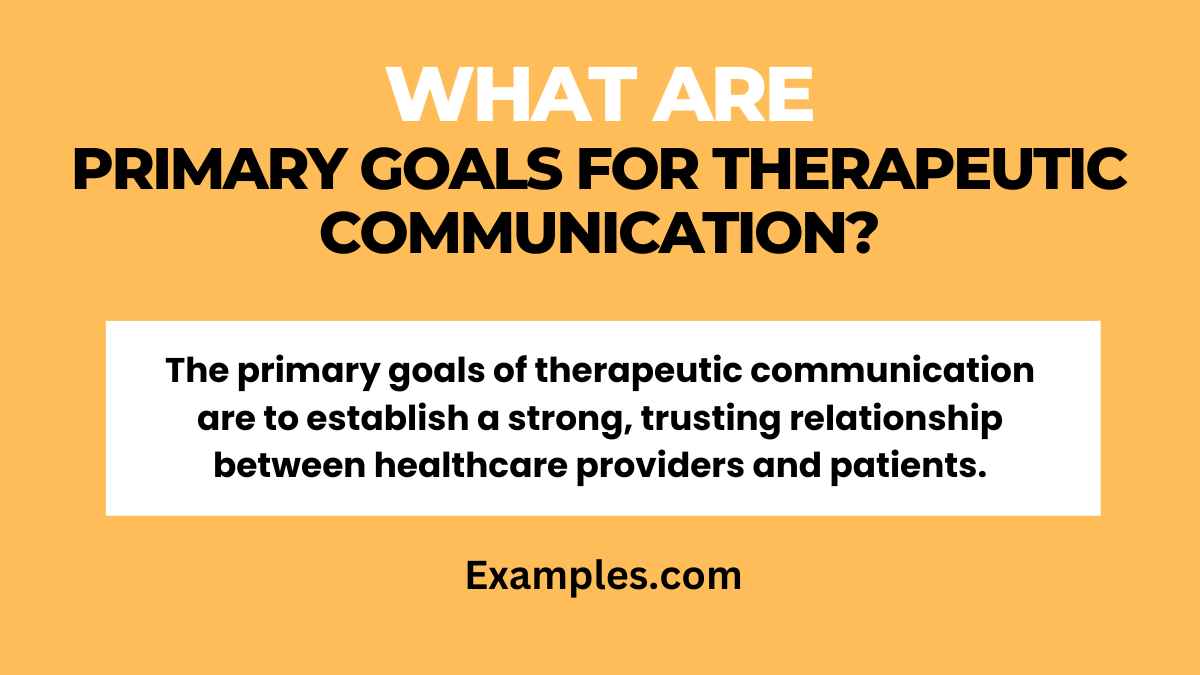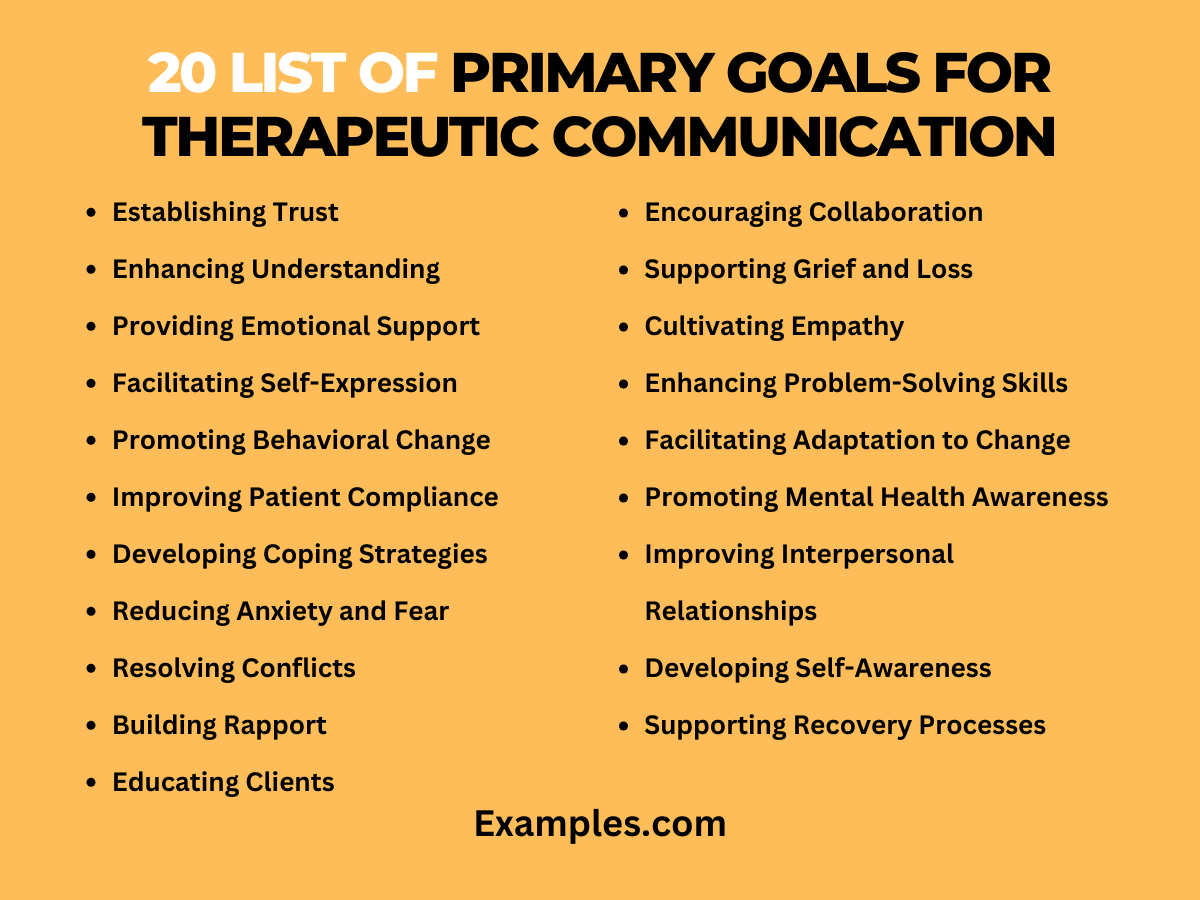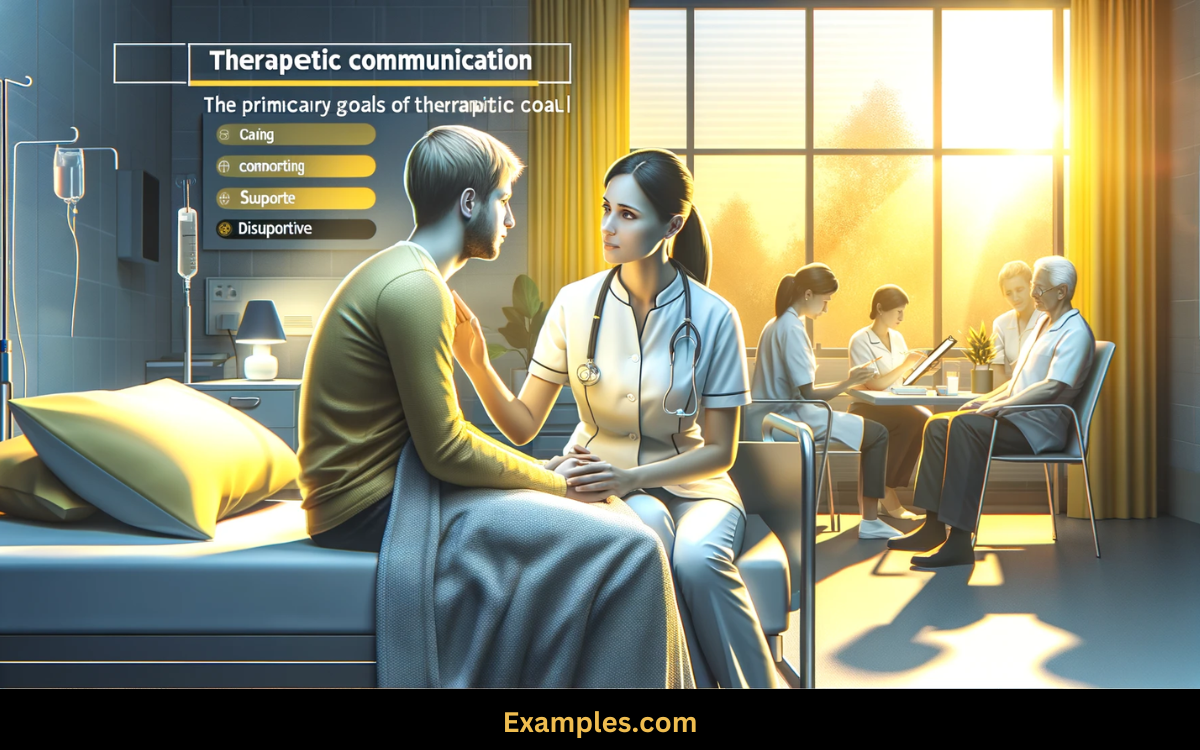19+ Primary Goals of Therapeutic Communication Examples
Delve into the heart of effective healthcare communication with this guide on the Primary Goals of Therapeutic Communication. Essential for healthcare professionals, this resource provides an in-depth look at how to achieve meaningful patient interactions. Incorporating oral communication examples, this guide will illuminate the key objectives of therapeutic communication, such as building trust, understanding patient needs, and facilitating emotional support, all crucial for successful patient care.
What are Primary Goals for Therapeutic Communication?

The primary goals of therapeutic communication are to establish a strong, trusting relationship between healthcare providers and patients, and to foster an environment where patients feel comfortable, heard, and understood. This form of communication aims to clarify and address patients’ needs, concerns, and emotions effectively. It involves actively listening, showing empathy, and responding in a way that promotes patient well-being and cooperation in care. The ultimate objective is to support the patient’s mental and emotional health, alongside their physical health, creating a holistic approach to care.
20 List of Primary Goals for Therapeutic Communication
Explore the vital objectives of Therapeutic Communication through our in-depth guide on its primary goals. These goals range from building trust and understanding to facilitating emotional healing and promoting behavioral change. Each goal is paired with an illustrative example and a comprehensive description, offering practical insights into the application and benefits of therapeutic communication in various settings, such as healthcare, counseling, and educational environments.

- Establishing Trust: Create a foundation of trust to foster open communication. For instance, a therapist consistently shows empathy and maintains confidentiality to build a trusting relationship with their client.
- Enhancing Understanding: Aim to fully understand the client’s perspective. A healthcare provider actively listens to a patient’s concerns and asks questions for clarification, ensuring they fully comprehend the patient’s situation.
- Providing Emotional Support: Offer support and empathy to clients. A counselor acknowledges and validates a client’s feelings, providing comfort and understanding.
- Facilitating Self-Expression: Encourage clients to express thoughts and emotions. A teacher uses open-ended questions to encourage a student to articulate their feelings and thoughts.
- Promoting Behavioral Change: Use motivational interviewing techniques to encourage positive behavioral changes. A health coach employs open questions and reflective listening to help a client identify and pursue their health goals.
- Improving Patient Compliance: Enhance patient adherence to treatment plans. A nurse explains the benefits and procedures of a treatment in a clear, empathetic manner to a patient.
- Developing Coping Strategies: Help clients develop effective coping mechanisms. A therapist guides a client in identifying and practicing stress-reduction techniques.
- Reducing Anxiety and Fear: Alleviate feelings of anxiety and fear through reassuring and calm communication. A dentist uses gentle and reassuring language to ease a patient’s dental anxiety.
- Resolving Conflicts: Employ communication skills to mediate and resolve disputes. A mediator facilitates a discussion between conflicting parties, aiming for a mutual understanding and resolution.
- Building Rapport: Establish a connection to create a comfortable communication environment. A social worker uses friendly and approachable language to build rapport with a new client.
- Educating Clients: Provide information and educate clients in an understandable way. A doctor uses simple terms and diagrams to explain a medical condition to a patient.
- Encouraging Collaboration: Promote collaborative discussions for shared decision-making. A team leader uses inclusive language and solicits input from all team members during meetings.
- Supporting Grief and Loss: Offer a supportive space for clients dealing with grief. A grief counselor listens attentively and acknowledges the pain of someone who is grieving.
- Cultivating Empathy: Show empathy towards clients’ situations and feelings. A nurse expresses understanding and compassion to a patient undergoing a difficult procedure.
- Enhancing Problem-Solving Skills: Help clients develop problem-solving abilities. A career counselor discusses various career options with a client, encouraging them to weigh the pros and cons.
- Facilitating Adaptation to Change: Support clients in adapting to life changes. A therapist helps a client navigate the emotional challenges of a major life transition.
- Promoting Mental Health Awareness: Raise awareness about mental health issues and treatments. A mental health advocate uses clear, informative communication to educate the public about mental health.
- Improving Interpersonal Relationships: Enhance clients’ skills in personal relationships. A family therapist guides family members in communicating more effectively with each other.
- Developing Self-Awareness: Encourage self-reflection and awareness. A yoga instructor incorporates mindful communication to help students connect with their inner experiences.
- Supporting Recovery Processes: Aid in the recovery process from illness or trauma. A physical therapist uses encouraging words to motivate a patient during rehabilitation exercises.
Therapeutic Communication Primary Goals in Nursing
Therapeutic communication in nursing is pivotal for patient-centered care and recovery. It aims to build rapport, understand patient needs, and provide emotional support, all of which are essential for effective healthcare delivery. This guide focuses on the primary goals of therapeutic communication in the nursing field, highlighting the critical role it plays in patient treatment and well-being. With clear, compassionate, and effective communication, nurses can significantly improve patient outcomes, enhance the healthcare experience, and foster a positive environment for both patients and healthcare providers.

- Building a Supportive Environment: Nurses create a caring atmosphere that fosters healing.
Example: Using comforting words and a gentle tone to make patients feel at ease. - Assessing Patient Needs: Effective communication helps in accurately assessing and addressing patient needs.
Example: Asking open-ended questions to understand the patient’s health concerns. - Facilitating Patient Education: Educating patients about their health condition and treatment plans.
Example: Explaining medical procedures in simple, understandable language. - Managing Patient Expectations: Setting realistic expectations regarding treatment and recovery.
Example: Clearly discussing potential outcomes and timelines. - Enhancing Patient Compliance: Encouraging patients to follow treatment plans and healthcare advice.
Example: Motivating patients to adhere to prescribed medication schedules. - Providing Emotional Support: Offering comfort and reassurance during difficult times.
Example: Showing empathy and understanding towards a patient’s fears or concerns. - Facilitating Decision Making: Helping patients make informed decisions about their care.
Example: Discussing the pros and cons of different treatment options. - Encouraging Patient Feedback: Seeking and valuing patient opinions regarding their care.
Example: Asking patients for their input on their treatment experience.
What is the Primary Goal of Therapeutic Communication Responses?
Building a Trusting Relationship
One of the primary goals is to build a trusting relationship between healthcare providers and patients. This trust is established through responses that show understanding, compassion, and respect. For example, using active listening in Therapeutic Communication demonstrates that the healthcare provider is fully engaged and values the patient’s perspective.
Ensuring Clear Understanding
Ensuring that both the healthcare provider and the patient clearly understand each other is another crucial goal. Techniques like clarification in Therapeutic Communication and paraphrasing in Therapeutic Communication are used to avoid misunderstandings and ensure that the patient’s concerns are accurately addressed.
Guiding Positive Patient Outcomes
The responses in therapeutic communication also aim to guide the conversation towards positive outcomes. This includes using strategies such as reflecting in Therapeutic Communication and summarizing in Therapeutic Communication to keep the conversation focused and productive.
What is the Primary Reason to Practice Therapeutic Communication?
Enhancing Quality of Care
The core reason for practicing therapeutic communication is to enhance the overall quality of care. This involves creating a supportive environment where patients feel comfortable and valued, which is essential for effective treatment and care.
Educating and Empowering Patients
Therapeutic communication is pivotal in educating and empowering patients about their health conditions and treatment. By employing empathetic and clear communication, healthcare providers can make complex medical information more accessible and understandable to patients.
Addressing Emotional and Psychological Needs
Another vital aspect of therapeutic communication is addressing the emotional and psychological needs of patients. Techniques such as addressing emotions first in Therapeutic Communication are crucial for providing holistic care that encompasses the mental and emotional well-being of patients.
In conclusion, therapeutic communication is not just a tool for effective healthcare delivery; it is an essential element in building trust, ensuring understanding, guiding patient outcomes, enhancing the quality of care, educating patients, and addressing their holistic needs.



